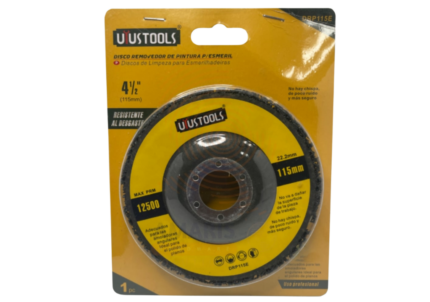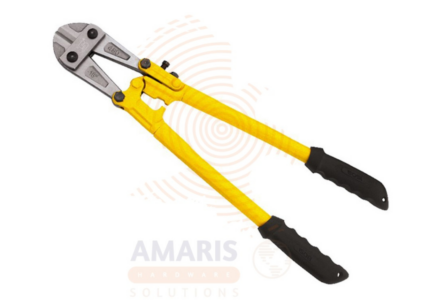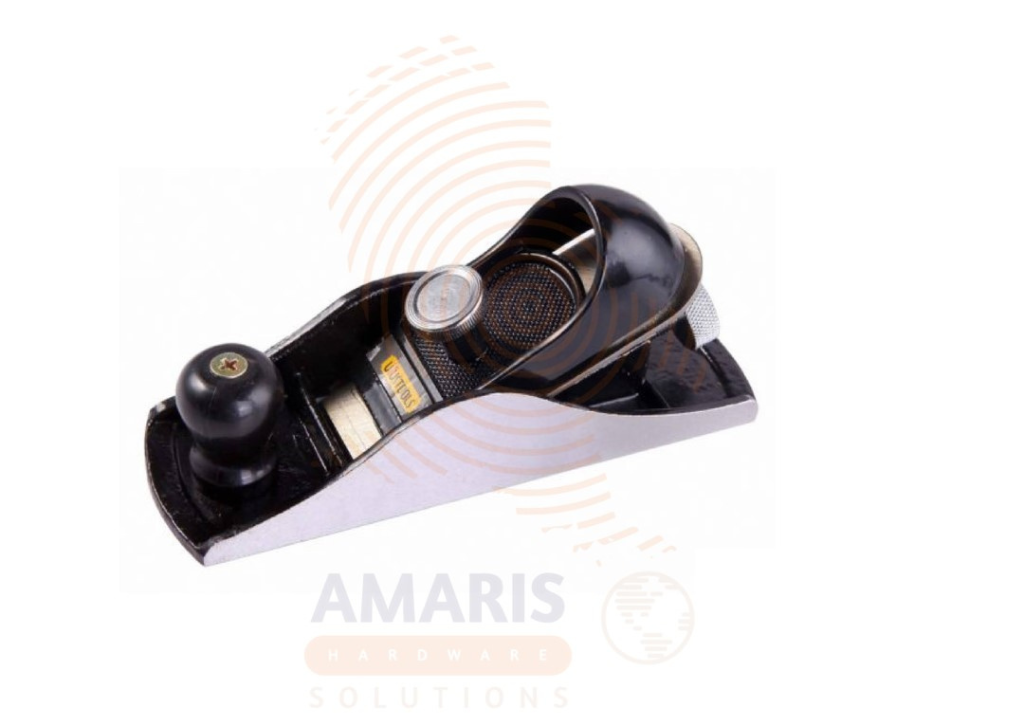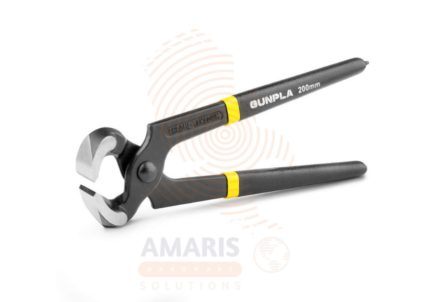
Black Abrasive Disc - Net Cover
$17.19 Original price was: $17.19.$16.33Current price is: $16.33.

Bolt Cutter
$63.46 Original price was: $63.46.$60.29Current price is: $60.29.
Block Plane
$25.77 Original price was: $25.77.$24.48Current price is: $24.48.
WhatsApp Order
A block plane is a small, handheld woodworking tool designed for trimming and shaping wood. It typically has a low-angle blade, set bevel up, which protrudes through the bottom of the plane at a fixed angle. Block planes are versatile and commonly used for tasks such as chamfering edges, smoothing end grain, and adjusting the fit of joints. Their compact size and easy maneuverability make them suitable for fine woodworking and detail work.
Description
Table of Contents
ToggleBlock Plane
Uses
-
Smoothing Surfaces: Block planes are excellent for smoothing surfaces of wood, particularly end grain. They help in achieving a clean and polished finish by removing small imperfections and tear-out.
-
Chamfering and Beveling Edges: Block planes are handy for creating chamfers and bevels on the edges of wood pieces. This is useful for adding decorative touches to projects or easing sharp edges.
-
Trimming End Grain: When working with wood, end grain can be challenging to smooth with other tools. Block planes excel at trimming and smoothing end grain surfaces efficiently.
-
Adjusting Joints: Block planes are often used to fine-tune the fit of joints, such as dovetails or tendons. They allow for precise adjustments to achieve a snug fit without altering the overall dimensions of the workpiece.
-
Shaping and Sculpting: Block planes can be employed for shaping and sculpting wood, especially when a more controlled and detailed approach is needed. They are effective for removing material gradually.
-
Flattening Small Surfaces: When working on small pieces of wood or adjusting the fit of a joint, a block plane can be used to flatten surfaces quickly and accurately.
-
Removing Sharp Corners: Block planes are useful for rounding off sharp corners, making the wood more comfortable to handle and enhancing the overall aesthetic of the project.
-
Planning Across the Grain: Unlike larger planes, block planes are well-suited for planning across the grain due to their low-angle blade. This makes them effective for certain grain orientation challenges.
-
Fine-tuning Miters: Block planes are handy for refining and adjusting the fit of miter joints, ensuring a tight and precise connection between pieces.
-
Quick Stock Removal: While not as powerful as larger planes, block planes can still remove material quickly, making them useful for tasks that require a more delicate touch compared to larger, more aggressive tools.
SAFETY HANDLING PRECAUTIONS
Safety Precautions
-
Wear Personal Protective Equipment (PPE):
-
Safety Glasses: Protect your eyes from wood chips, dust, and potential debris by wearing safety glasses or goggles.
-
Hearing Protection: If the noise from the planning process is loud, consider wearing ear protection to prevent hearing damage.
-
-
Secure Workpiece Properly:
-
Ensure that the workpiece is securely clamped or held in place before starting to plane. This prevents the wood from shifting unexpectedly, reducing the risk of injuries.
-
-
Keep Hands Away from the Blade:
-
Always keep your hands at a safe distance from the cutting edge of the blade. Use the handle of the plane for control and keep your fingers away from the path of the blade.
-
-
Check and Sharpen the Blade:
-
Before use, inspect the blade for any damage or dullness. A sharp blade reduces the force needed to push the plane, making it easier to control. Follow proper sharpening procedures when necessary.
-
-
Plane in the Direction of the Grain:
-
Work with the natural grain direction of the wood to minimize tear-out and achieve smoother results. Planning against the grain can lead to splintering and rough surfaces.
-
-
Maintain a Controlled Pace:
-
Avoid rushing the planning process. Maintain a controlled and steady pace, letting the blade cut through the wood at its own rate. This enhances safety and improves the quality of the work.
-
-
Mind Your Body Position:
-
Stand in a stable position with your feet shoulder-width apart to maintain balance. Keep your body to the side of the plane, not directly behind it, to avoid injury in case of a slip.
-
-
Use a Proper Work Surface:
-
Work on a stable and flat surface to ensure better control of the block plane. Avoid slippery or uneven surfaces that could lead to accidents.
-
-
Store Properly When Not in Use:
-
When you're finished using the block plane, store it in a designated area away from the reach of children. Keep the blade retracted or protected to prevent accidental contact.
-
-
Follow Manufacturer's Instructions:
-
Familiarize yourself with the manufacturer's guidelines and instructions for your specific block plane. Adhering to recommended practices ensures safe and effective use.
-
-
Stay Mindful and Alert:
-
Avoid distractions while using the block plane. Stay focused on the task at hand to prevent accidents caused by loss of concentration.
-
Related products
Ball Point Hex Wrench Set – Short
A Ball Point Hex Wrench Set - Short refers to a collection of nine hexagonal (hex) wrenches, commonly known as Allen wrenches, designed with a ballpoint tip for easy access and angled entry into hexagonal socket screws. The term "short" indicates that these wrenches have shorter shafts compared to standard-sized wrenches. This set is likely to be compact and versatile, suitable for various applications where hex screws of different sizes need to be tightened or loosened efficiently. The ballpoint tips allow for a degree of flexibility in the angle of approach, making them particularly useful in situations where direct access may be challenging.
Bi-Metal Hole Saw Set
A 9 PCS Bi-Metal Hole Saw Set refers to a collection of nine hole saws, each constructed with a bi-metal design. A hole saw is a cylindrical cutting tool used to create holes in various materials such as wood, metal, plastic, and more. The term "bi-metal" indicates that the hole saws are made from two different types of metals, typically high-speed steel (HSS) and a more durable alloy like cobalt. This combination enhances the hole saw's cutting performance, making it suitable for a wide range of applications and providing increased durability and longevity. The set typically includes hole saws of different sizes to accommodate various hole diameters, making it a versatile tool for professionals and DIY enthusiasts alike.
C Clamp Locking Pliers
A C clamp locking pliers, often simply referred to as locking pliers or Vise-Grips (a popular brand name), is a versatile hand tool designed for gripping, clamping, and holding objects securely. The tool features an adjustable locking mechanism that allows it to maintain a constant grip force on the object, freeing the user's hands for other tasks. The jaws of the pliers are shaped like a C-clamp, providing a strong and secure grip on various shapes and sizes of objects. This makes C clamp locking pliers particularly useful in situations where a stable hold is required, such as in woodworking, metalworking, automotive repair, and general DIY applications.
Carpenter’s Pencil – Hexagon
A Carpenter's Pencil Hexagon refers to a pencil specifically designed for carpentry work, characterized by its hexagonal shape. Unlike traditional round pencils, the hexagonal shape of a Carpenter's Pencil prevents it from rolling off surfaces and provides a more secure grip, making it practical for precision and control in carpentry tasks. The design also allows for easy identification and retrieval among other tools on a busy work site. Additionally, Carpenter's Pencils often feature a flat or rectangular cross-section, further preventing them from rolling and making them convenient for marking lines with straight edges.
Carpenter’s Pincers
Carpenter's pincers, also known as end-cutting pliers or end nippers, are a type of hand tool used in carpentry and woodworking. They typically have sharp, pointed jaws that come together in a cutting edge at the tips. These pincers are designed for gripping, cutting, and pulling materials such as nails, wires, or small objects in woodworking applications. The jaws are angled to provide leverage and facilitate precise cutting or gripping in tight spaces. Carpenter's pincers are a versatile tool commonly found in a carpenter's toolkit for various tasks related to shaping and assembling wood.
Countersink Drill Set
A countersink drill set typically refers to a collection of six tools designed for countersinking operations in woodworking or metalworking. Each set usually includes six individual countersink drills with varying sizes or angles. Countersinking is a process that involves creating a conical hole in a material, allowing the head of a screw or bolt to sit flush with or below the surface. These drill sets are essential for achieving a professional finish in various applications where a smooth and even surface is desired, such as in carpentry, metal fabrication, or DIY projects.
Die Set
An Die Set typically refers to an 8-piece die set used in various manufacturing and machining processes. In manufacturing and metalworking, dies are specialized tools used to shape, cut, or form materials such as metal, plastic, or other substances. A die set, in this context, is a collection of individual dies designed to work together for specific tasks.
Flat Hand Steel File
PRODUCT DESCRIPTION
A flat hand file is a type of hand tool used in metalworking and woodworking to remove material from a workpiece by abrasion. It consists of a flat, elongated piece of metal with parallel rows of teeth or ridges, called the file's "cut," which are designed to cut or shape a material when rubbed against it. Flat hand files are typically rectangular in shape and come in various sizes and coarseness grades, allowing for different levels of material removal and finishing. These files are commonly used for smoothing, shaping, and leveling surfaces in a variety of applications, providing a versatile means of material removal in manual craftsmanship.


 Acrylic Sealants
Acrylic Sealants Construction Adhesives
Construction Adhesives Double-Sided Tape
Double-Sided Tape Duct Tape
Duct Tape Electrical Tape
Electrical Tape Epoxy & Resins
Epoxy & Resins Masking Tape
Masking Tape
 Automotive Wrenches & Socket Sets
Automotive Wrenches & Socket Sets Battery Chargers & Jump Starters
Battery Chargers & Jump Starters Car Jacks & Stands
Car Jacks & Stands Car Wash & Detailing Products
Car Wash & Detailing Products Diagnostic Tools
Diagnostic Tools Tire Inflators
Tire Inflators Vehicle Lighting
Vehicle Lighting Oil & Lubricants
Oil & Lubricants
 Adhesives & Sealants
Adhesives & Sealants Bricks & Blocks
Bricks & Blocks Cement & Concrete
Cement & Concrete Drywall & Plaster
Drywall & Plaster Flooring (Tiles, Wood, Laminate)
Flooring (Tiles, Wood, Laminate) Lumber & Plywood
Lumber & Plywood Paints, Primers & Coatings
Paints, Primers & Coatings Insulation Materials
Insulation Materials Roofing Materials
Roofing Materials
 Circuit Breakers
Circuit Breakers Electrical Cables & Wires
Electrical Cables & Wires Switches & Sockets
Switches & Sockets Fuses & Relays
Fuses & Relays Connectors & Terminals
Connectors & Terminals Electrical Boxes & Panels
Electrical Boxes & Panels Conduit & Fittings
Conduit & Fittings Lighting Fixtures & Bulbs
Lighting Fixtures & Bulbs Extension Cords & Power Strips
Extension Cords & Power Strips
 Anchors
Anchors Bolts
Bolts Clips & Clamps
Clips & Clamps Screws
Screws Nuts
Nuts Washers
Washers Rivets
Rivets Nails
Nails Threaded Rods
Threaded Rods
 Hammers
Hammers Measuring Tools (Tapes, Levels, Calipers)
Measuring Tools (Tapes, Levels, Calipers) Screwdrivers
Screwdrivers Pliers & Cutters
Pliers & Cutters Saws & Blades
Saws & Blades Chisels & Punches
Chisels & Punches Allen Keys & Hex Keys
Allen Keys & Hex Keys Ratchets & Socket Sets
Ratchets & Socket Sets Wrenches & Spanners
Wrenches & Spanners
 Power Tool Accessories (Blades, Bits, Discs)
Power Tool Accessories (Blades, Bits, Discs) Rotary Tools
Rotary Tools Saws (Circular, Jigsaw, Reciprocating)
Saws (Circular, Jigsaw, Reciprocating) Drills & Drivers
Drills & Drivers Grinders & Sanders
Grinders & Sanders Heat Guns
Heat Guns Nail Guns
Nail Guns Impact Wrenches
Impact Wrenches Batteries & Chargers
Batteries & Chargers
 Pipes & Fittings (PVC, Copper, PEX)
Pipes & Fittings (PVC, Copper, PEX) Plumbing Tools
Plumbing Tools Pumps & Motors
Pumps & Motors Sealants & Adhesives for Plumbing
Sealants & Adhesives for Plumbing Valves & Taps
Valves & Taps Water Heaters
Water Heaters Drainage Systems
Drainage Systems Faucets & Fixtures
Faucets & Fixtures Hoses & Tubing
Hoses & Tubing
 Hinges & Latches
Hinges & Latches Hooks & Brackets
Hooks & Brackets Window Hardware
Window Hardware Chains & Cables
Chains & Cables Casters & Wheels
Casters & Wheels Shelving & Storage Systems
Shelving & Storage Systems Door Handles & Locks
Door Handles & Locks Drawer Slides & Cabinet Hardware
Drawer Slides & Cabinet Hardware
 Personal Protective Equipment (PPE)
Personal Protective Equipment (PPE) Respirators & Masks
Respirators & Masks Safety Glasses
Safety Glasses Safes
Safes Security Cameras
Security Cameras Gloves
Gloves Helmets
Helmets Ear Protection
Ear Protection Fire Safety Equipment
Fire Safety Equipment Locks & Padlocks
Locks & Padlocks Motion Sensors & Alarms
Motion Sensors & Alarms
 Garden Fencing
Garden Fencing Garden Furniture Hardware
Garden Furniture Hardware Lawn Mowers
Lawn Mowers Trimmers & Edgers
Trimmers & Edgers Shovels & Spades
Shovels & Spades Rakes & Hoes
Rakes & Hoes Pruning Shears & Loppers
Pruning Shears & Loppers Watering Systems (Hoses, Sprinklers, Nozzles)
Watering Systems (Hoses, Sprinklers, Nozzles)
 Interior Paints
Interior Paints Paint Brushes & Rollers
Paint Brushes & Rollers Paint Strippers & Thinners
Paint Strippers & Thinners Paint Trays & Accessories
Paint Trays & Accessories Exterior Paints
Exterior Paints Spray Paints
Spray Paints Primers & Undercoats
Primers & Undercoats Varnishes & Stains
Varnishes & Stains
 Gaskets & Seals
Gaskets & Seals Hydraulic Fittings
Hydraulic Fittings Industrial Fasteners
Industrial Fasteners Industrial Hoses
Industrial Hoses Lubricants & Greases
Lubricants & Greases Metal Sheets & Bars
Metal Sheets & Bars Bearings & Bushings
Bearings & Bushings Belts & Pulleys
Belts & Pulleys
 HVAC Filters
HVAC Filters Insulation for HVAC
Insulation for HVAC Air Conditioners
Air Conditioners Refrigerants
Refrigerants Ventilation Ducts & Fittings
Ventilation Ducts & Fittings Thermostats & Controllers
Thermostats & Controllers Fans & Blowers
Fans & Blowers
 Pegboards & Hooks
Pegboards & Hooks Shelving Units
Shelving Units Storage Bins & Containers
Storage Bins & Containers Toolboxes & Tool Chests
Toolboxes & Tool Chests Workbenches
Workbenches Drawer Organizers
Drawer Organizers Labeling Supplies
Labeling Supplies
 Welding Accessories (Clamps, Brushes)
Welding Accessories (Clamps, Brushes) Welding Electrodes & Rods
Welding Electrodes & Rods Welding Helmets & Gloves
Welding Helmets & Gloves Welding Machines
Welding Machines Soldering Irons & Stations
Soldering Irons & Stations Flux & Solder Wire
Flux & Solder Wire
 Generator Accessories
Generator Accessories Inverters
Inverters Portable Generators
Portable Generators Power Inverters
Power Inverters Transfer Switches
Transfer Switches Diesel & Gasoline Generators
Diesel & Gasoline Generators
 Transport Equipment: Carts, Dollies, and Hand Trucks
Transport Equipment: Carts, Dollies, and Hand Trucks Storage Solutions: Pallets, Racks, and Containers
Storage Solutions: Pallets, Racks, and Containers Lifting Equipment: Hoists, Cranes, and Jacks
Lifting Equipment: Hoists, Cranes, and Jacks Conveyors and Accessories: Belts and Rollers
Conveyors and Accessories: Belts and Rollers









